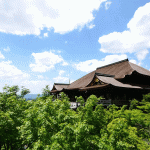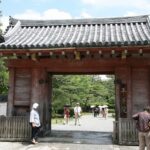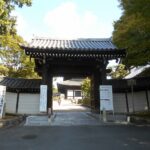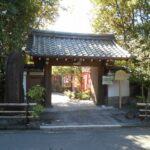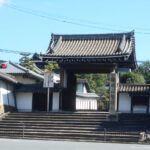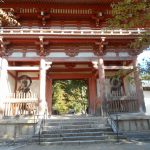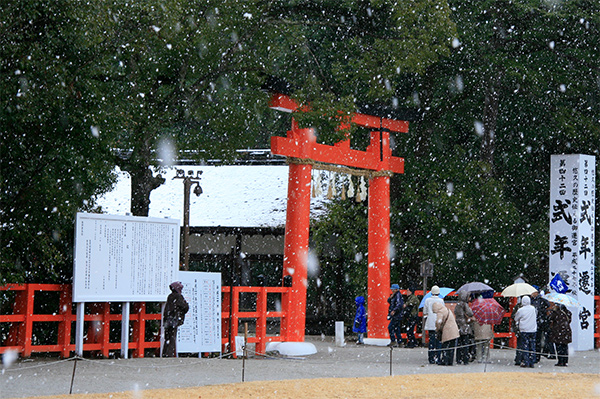
Kamigamo-jinja Shrine(上賀茂神社)

Location-Access
This shrine is located in Rakuhoku Area to the North of Kyoto.
We take about 50 minutes from Kyoto station to Kamigamo Jinja-mae by city bus # 4, and 5 minutes walk. Or it takes 40 minutes from Kyoto sta. to Kitaoji by subway and from Kitaoji to Kamigamo Goenbashi by city bus North#3.
(この神社は京都北部洛北エリアに位置する。
市バス 4系統で京都駅から下鴨神社前、徒歩5分で計約45分。
又は、地下鉄(京都駅-北大路)+市バス北3系統(北大路-上賀茂御薗橋)で40分かかる。)
MAP
Who was built this temple?
- This shrine has the oldest Shinto shrine in Kyoto among the oldest shrine.
In 678,Founded to deity the ancestors of Kamo chan who had held this region for a long time. Kamo-wakeizuchi jinja shrine, popularly called Kamigamo-jinja on World Heritage by UNESCO.
(京都の数ある神社の中で最も古い歴史を持つ神社である。
678年、長い間、この地を治めていた賀茂一族の祖先を祀るために創てられた。)
- It had already acquired considerable fluence by the end of 7th
After the establishment of Heian-kyou, it attracted many worshippers in the Imperial Court as a shrine for pacification and protection of nation.
(7世紀末には、すでに有力な神社であった。平安建設以降は国家鎮護の神社として朝廷の崇敬を集めていた。)
- By the beginning of 11th century, the shrine building had been built in nearly their present forms, but gradually deteriorated thereafter.
(社殿は11世紀初頭までに現在に近い姿に整えられたが、その後、衰退した。)
- The restoration work in 1628 extended over the entire shrine precincts, referring to the historical records, painting and sketches. It was restored as it had been in the Heian period(794-1184). After restoration the Honden(main shrine building) was rebuilt seven times. The present Honden and Gonden (associate shrine building) were rebuilt in 1863.
(社殿は11世紀初頭までに現在に近い姿に整えられたが、その後、衰退した。
1628年再興は歴史記録、絵画、スケッチを参考にして及び、平安時代状況の再現がされた。
再興後、本殿造替が7回実施されており、現在の本殿と権殿は1863年に再建された。)
- The crest of the Kamigamo Shrine features the leaves of holly hock, and said to have inspired the Tokugawa Shogunate to use a similar crest of Shimogamo Shrine.
(上賀茂神社の家紋は三つ葉葵が特徴であるが、下鴨神社の家紋を使用して徳川幕府をスポートした。)
- Iemitsu TOKUGAWA is said to have had a deep respect for this shrine, which, along with a nember of Kyoto shrines and temples was made of a World Heitage Site in 1994.
(徳川家康はこの寺を深く信仰し、1994年上賀茂神社は、京都の他の寺院・神社と共に世界遺産に登録された。)
Was made a World Heritage Site in 1994.
Was made a World Heritage Site in 1994.
(1994年に世界遺産に登録された。)
What is this temple famous for ?
Annual Event 年中行事
1/10 Gonaigikigan, 1/16Busyasinji( Archery), 2/14Kigensai, 2/24Kozaisai, 4/3 Kamo kyosun-en, 5/4Saioudaimitigiri , 5/15Kamosai Festival(Aoi Festival), 6/10 Otauesai , 7/1 Gamogotodainou(Makino), 7/26Kamono Mizumaturi,
9/9Choyousinnzi and Karasuzumou, 9/13Kamokanngetusai, 10/20 Kasagakesinzi(Archery), 10/22 Festival of the Eras, 11/13Ainamesai
(1/10御内儀祈願、1/16武射神事、2/14紀元祭、2/24幸在祭、4/3賀茂曲水宴、5/4斎王代御契、5/15賀茂祭(葵祭)、6/10御田植祭、7/1賀茂御戸代能(薪能)、7/27賀茂の水まつり、
9/9重陽神事と烏相撲、9/13賀茂観月祭、10/20笠懸神事、10/22時代祭、11/13 相当祭)
Honden and Gonden 本殿と権殿
The Honden and Gonden are of the same size, about 5.5m across and 3.7m long from back to back, and the same shape situated along East West axies. They are built in Nagare-dukuri(following) style of architecture with prayer porticos in front. Their Nagare show an ancient style.They are both designated as National treasures.
(本殿と権殿は同大・同建築様式で東西に並んでいる。正面3間(5.5m)@副面(3.7m)で正面に向拝を付けた流造りで、正面の流れを長くしている点に本殿形式の古制がよく示している。
両殿とも国宝である。)
Aoi Festival 葵祭(6時間)
One of Kyoto’s most famous festival, or the Kamo Festival. Recognized as one of Kyoto’s Big Three Festivals, the Aoi Festival is held every May 15 at the Shimogamo and Kamigamo Shrine.
Over 500 people take part in the elegant procession recreating the departure from Kyoto Old Emplace, passing from the Shimogamo to the Kamigamo Shrine by the Heian period aristocracy.
(京都を代表する祭りの一つである葵祭又は賀茂祭がある。京都の三大祭として数えられており、毎年5月15日に上賀茂神社、下鴨神社の両社例祭である。500人以上の人々が平安貴族の装束で優雅な古典行列は、京都御所を出発し下鴨神社を経て上賀茂神社へ向う。)
What is highlight?
大鳥居 Otorii ( the huge vermillion)
The huge vermillion Torii gate is an impressive site, and tale you into a sacred world.
On entering, the wide open space, where Aoi Festival is staged, allow visitors calm their minds before supplication.
(巨大な朱色の一の鳥居は印象的な場所で聖地へ導きます。
葵祭の時に広場へ入り、神に祈願する前に観光客を静寂にする。)
しだれ桜 Weeping cherry
The weeping cherry tree found between the first and second tori gates is also very famous.(一の鳥居と二の鳥居の間にある「しだれ桜」も有名である。)
参道 Sando
The procession of Aoi Festival, which is the festival of Shimogamo and Kamigami Shrine passes on the path. Do you know why people call it the Aoi Festival?
Because the people and the ox carts will be decollated with futaba aoi leaves.
After we pass by the second tori, we can see on historical building another. Most of them are designated cultural properties.
(下鴨神社と上賀茂神社の祭である葵祭の行列もここを通る。なぜ葵祭というか知っている。行列に参加する人や牛車をフタバアオイの葉で飾るから。二つ目の鳥居から先は、歴史がありそうな建物が多い。ほとんどが文化財指定を受けている。)
細殿 Hosodono
On passing through the second tori gate, visitors find themselves before the main worship hall, with two large cones of sand displayed out front.
The mark the spot where the god of Kamigamo Shrine is said to have descended to earth.
The contract of shadow and light on the Kamigamo Shrine is said to be one of highlight of a visit to the shrine. The white gravel on the entrance path of Kamigami Shrine. is very beautiful.
(二の鳥居をくぐると、本殿へ行く前に円錐型に盛った砂「立砂」が並んでいる。
これらは神社の神が降りたとされる神山を示したものである。
陽と陰を表した「立砂」も上賀茂神社も見どころの一つである。)
本殿 Main building (National treasure)
The Main hall of Kamigamo Shrine is listed as National treasure of Japan because it has typical “Nagare-zukiri” construction. The front side of roof is longer than back side of it.
Though we van’t see it usually.
(上賀茂神社は、「流造り」の代表であるため、日本の国宝として登録されている。
屋根の前側は後ろ側より長い。しかし、通常本殿は見れない。)
片岡社 Kataoka-sya
At Kataoka-sya Tamayoribine is enshrined. It’s the most important sub-shrine in Kamigamo Shrine because Tamayoribine is a Mother ‘s diety of Kamigamo Shrine.
(片岡社では、玉より姫が祀られている。玉より姫は上賀茂神社の神母であるため重要な副社殿である。)
橋殿/舞殿 Hashidono/Maidono (National Treasure)
We put “Hitogata” on the stream from Hashidono on “Nagoshi-no-harae” ritual. In ritual, Hitogata bring anything evil away.
(名越しの離れの儀式の上で橋殿から人型を置く。人型は鬼を運び出す。)
武射神事 Musyashinji
This attractions include the Mushashinji, a ceremony every January 16 in which the world for demon, or oni is written on the back of the archery targets and shot at in order to disposal bad luck.
(1月16日「武射神事」は、鬼と書かれて的を射て年中の邪気を祷う行事のことである。)
渉渓園 Syokei-en
Syokei-en is a garden made for “Kyokusuien”. At 2nd Sunday of April, Kamo Kyukusui-en was held and we can see Sachi-dai of last year. There is a stream in Syokei-en.
Composer on “Waka” sit along the stream. Read the poetry before a dish of sake pass through and drink sake. Flow a dish of sake.
(渉渓園は曲水宴の庭である。4月第2日曜日賀茂曲水宴が行われ、昨年は斎王代を見れた。渉渓園には流れがあり、和歌の詠み手が流れに沿って座っている。流れている盃が自分の前を通り過ぎる前に詩歌を読み、盃の酒を飲んで盃を次に流す。)
重陽の節句と烏相撲
In September, you can see Karasuzumo, or crow sumo wresling.Two men in white traditional cloths make the sound of crows,and dozens of children perform sumo wrestling as an offering to the gods.
(9月には、烏相撲が行われる。白装束の2人がカラスの鳴き真似した後、子供が相撲を奉納する。)
